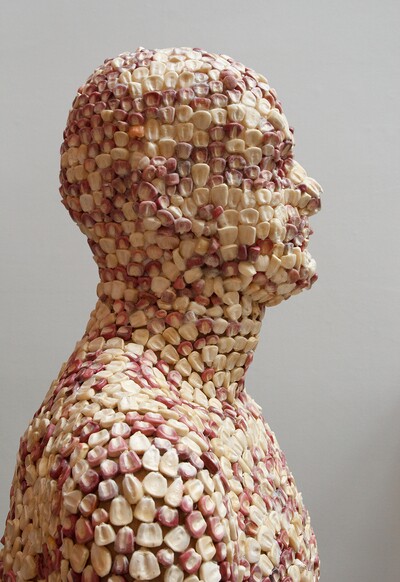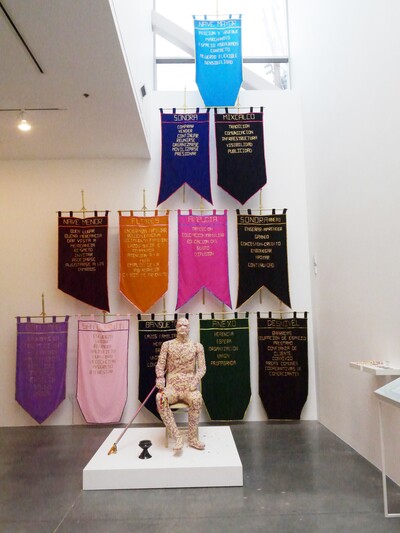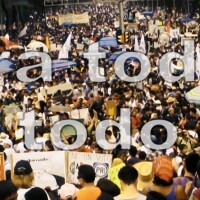Corn Man: A Mexican-Inspired Animistic Sculpture Arrives in Santa Ana and Los Angeles

This is produced in partnership with Pacific Standard Time: LA/LA, a far-reaching and ambitious exploration of Latin American and Latino art in dialogue with Los Angeles.

Performance art in Latin America was prolific from the 1960s to 80s — at a time of aggressive authoritarianism. As the political climate evolved there in the 1990s, this interdisciplinary art genre advanced with a new generation of artists exploring its possibilities.
“Corn Man,” a Latin American-inspired art piece — scheduled for performances in Santa Ana and other U.S. cities — is a life-size seated mannequin, completely covered with dried corn kernels. Currently installed in Otis College’s “Talking to Action: Art, Pedagogy, and Activism in the Americas” exhibition, he was assembled by artist Alfadir Luna of Mexico City, and by Alejandro Olivares, a Cal State Fullerton art student, in September in downtown Santa Ana.
Corn Man is a proxy of the original Señor del Maíz, who was built by Luna in 2006 in Mexico City’s “La Merced” downtown public market. When Luna presented his corn sculpture concept to the Mexican merchants, many embraced the idea and even took on responsibility for the animistic figure’s various body parts. In time, Señor del Maíz became a major figure in La Merced’s ceremonies and processions — as he was said to be imbued with spiritual powers, and with the capacity to bring fortune to all who interact with him. These downtown market processions occur Luna says, “on the first Tuesday of the first crescent moon in October, or a time of rebirth.”
Why then build a sculpture of corn in Santa Ana and display him at Otis College of Art and Design? Luna and Bill Kelley, Jr., the “Talking to Action” exhibition curator, see a kinship between La Merced and Santa Ana’s Fourth Street Market; and they feel that a local version of Corn Man will work as well in this U.S. city as in Mexico. In Santa Ana — located 35 miles southeast of Los Angeles — all seven members of the City Council and 78 percent of the residents are Latino (with many of Mexican heritage), making it one of the most densely Latino-populated cities in the country. Kelley, Jr. adds that Santa Ana is inhabited by people of the diaspora, many of whom have strong memories of their heritage and homeland.
Corn Man’s genesis in the U.S. began in 2015 when Kelley, Jr., a professor of Latin American and Latino art history, Cal State, Bakersfield, was a Grand Central Art Center artist-in-residence. During his residency, he engaged in dialogues about the upcoming Pacific Standard Time: LA/LA initiative. He explored PST: LA/LA’s local aspects while investigating Southern California and adjacent Tijuana. Grand Central’s director John Spiak explains, “Bill connected with artists, students and professors from the region and discussed projects with Grand Central, including collaborating with Luna.”
Luna, who has also been a GCAC artist-in-residence, graduated from the National Institute of Fine Arts, Mexico City in 2008 with a concentration in “social practice,” an art genre engaging the public in social causes. While in art school, he began spending time in La Merced (with its rich pre-Columbian history, in the site of an old Aztec temple), creating drawings of the markets, merchants and customers. In 2006, he proposed building a human-sized figure made of corn or Señor del Maíz, in part because corn, first grown in Mexico nearly 10,000 years ago, has provided sustenance for humanity ever since. Ancient Mexicans also believed that humanity is made of corn and that it links us back to the earth. Conversely and equally important, much of the corn today is genetically modified, affecting biodiversity, particularly among indigenous people.
With more than a decade working with and promoting Señor del Maíz, Luna was excited to build Corn Man in Santa Ana. He decided to build Corn Man in front of the Virgen de Guadalupe, a seven-foot-tall relief sculpture near Santa Ana's Fourth Street Market. He explains, “It is next to the place where the carousel was (which was taken down in 2011) and near the historic Yost Theater. I would work in the pedestrian street, as the Corn Man project is about identity, memory, history, culture, peasants, agrarian and indigenous issues, industry and genetics. I would talk with people who pass by and may be interested in this sculpture." As Luna had engaged in dialogues and conducted research with local merchants during two previous Grand Central residencies, he repeated this socially engaged practice this year while assembling Corn Man. The merchants, many of them born in Mexico, embraced the sculpture, and look forward to participating in ceremonies with him when he returns in 2019.

Corn Man left Santa Ana in mid-September and was brought to the Ben Maltz Gallery at Otis College to be part of the current “Talking to Action” installation there. The exhibition explores political and environmental activism, community organizing, and performance art in Latin American countries. Curator Kelley, Jr. regards Corn Man as a key element of the show, providing social and spiritual connections. “Since 2006, Alfadir Luna has worked mainly with public markets, which he perceives as a breeding ground for the development of social actions that culminate as site-specific interventions,” Kelley, Jr. explains. “He developed a network of collective actions that promoted the participation of merchants with Señor del Maíz.”

Kelley, Jr. has himself researched Mexican public markets for their rich history, providing, he theorizes, “diverse perspectives on non-Western knowledge, ritual practices, symbolic languages, economic and commercial values.” He adds that the recently completed Corn Man is a vehicle for community organizing, and as an emissary gift from the merchants in Mexico to their colleagues in Santa Ana, he links the concerns of both communities. As a spiritually-endowed sculpture, he is given an elevated status by the community. In turn, he is beholden to protect the community.
When Corn Man was completed, Luna was queried about why he created a man, and not a woman, out of corn. He replied, "Corn Man establishes a reference to the tradition of Centéotl, a deity of corn (or the Aztec god of maize) who is translated as masculine. Although Corn Man refers to this tradition, if you look closely at the sculpture, a gender is not assigned. While referencing this tradition, we seek to provoke the question without answering it and without falling into the politically correct.”
As part of “Talking to Action,” Corn Man will leave Los Angeles with the exhibition when it closes in December and will travel to the School of the Art Institute of Chicago, Arizona State University in the Phoenix area, and to Yerba Buena Center for the Arts, San Francisco. Then he will tour Latin America, including the Distrito Federal in Mexico. Kelley, Jr. adds that at each stop, Corn Man is intended to be accompanied by a procession or ceremony.
In 2019, Luna and Kelley, Jr. will return to Santa Ana with Corn Man. They along with the merchants will stage a ceremony with him, after which, the sculpture made of corn will be dis-assembled and all of the corn will be removed. The corn will be placed into small pouches, or “bolsas de abundancia,” along with other small treasures, and will be presented to the merchants in Santa Ana. Kelley Jr. explains, “This Corn Man will then cease to exist, but will exist only as corn.”
Top Image: Señor del Maiz | Courtesy of Alfadir Luna





